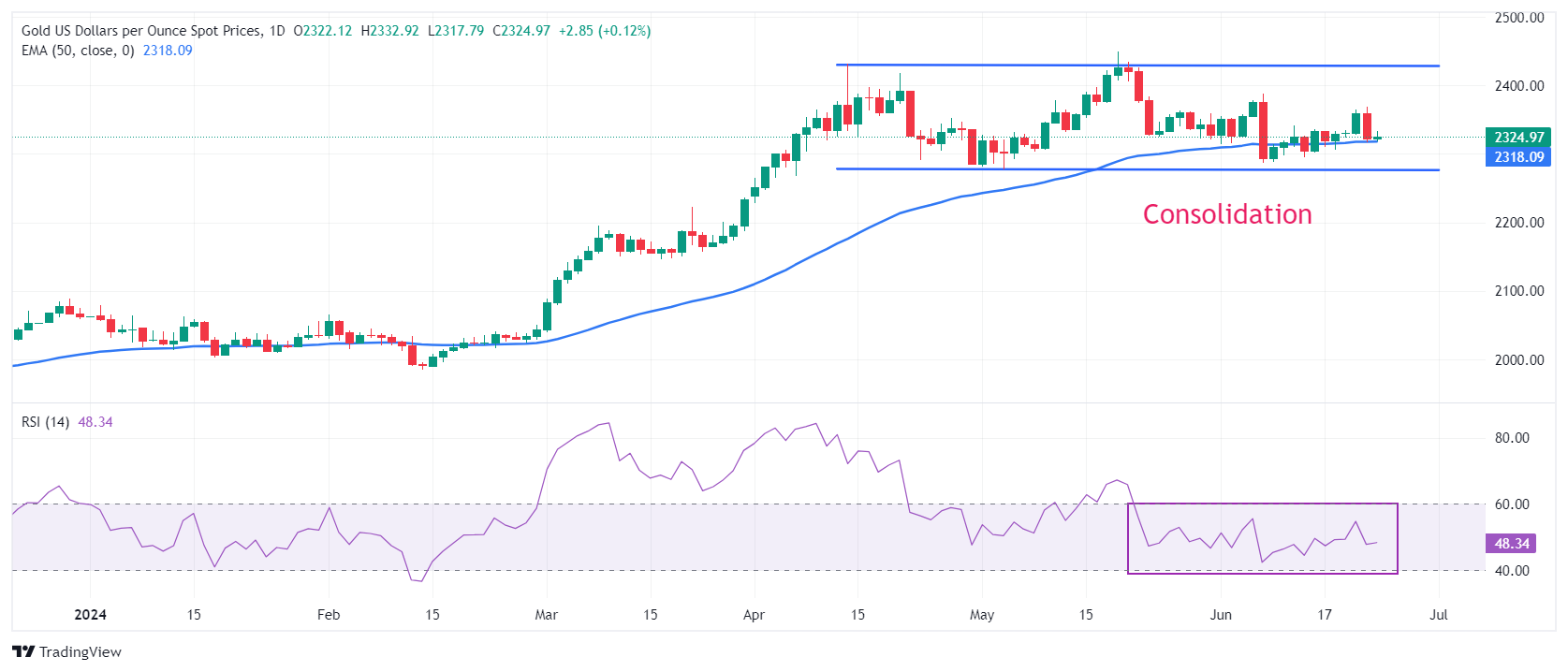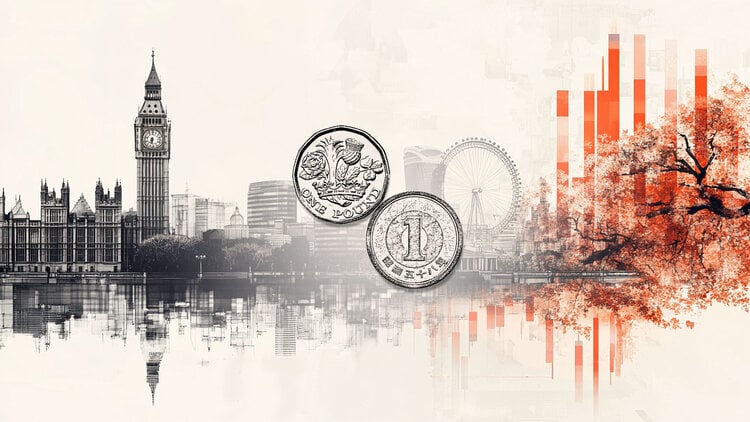- Gold price rebounds from $2,315 as US bond yields come under pressure on Monday.
- Investors see the Fed cutting interest rates twice this year.
- The US economic outlook improved as the preliminary PMI expanded at a faster pace in June.
Gold price (XAU/USD) attracts bids near $2,315 in the European session on Monday as US bond yields decline amid strong speculation that the Federal Reserve (Fed) will make two rate cuts this year. Expectations that the Fed will cut interest rates twice in 2024 strengthened amid easing inflation pressures in the United States (US). US 10-year Treasury yields fall near 4.25% on Monday.
The US Consumer Price Index (CPI) report showed that price pressures slowed more than expected in May. Additionally, S&P Global’s preliminary Purchasing Managers’ Index (PMI) report for June showed signs of a moderate cooling in cost growth. “Selling price inflation cooled to a five-month low in June. However, the rate of increase fell to a five-month low in the services sector, where the increase was one of the lowest seen in the last four years, and a minimum of six months in manufacturing,” the report said.
CME’s FedWatch tool suggests the central bank will begin the policy easing drive at the September meeting and make subsequent rate cuts in November or December. Price data for 30-day federal funds futures indicates that the probability of a rate cut in September is 66%.
By contrast, according to the dot plot in the FOMC’s June economic projections, Fed officials expect interest rates to be cut just once this year. Officials want to see inflation decline for months before moving to the policy normalization process.
Daily Moves and Market Drivers: Gold Price Rebounds as US Bond Yields Decline
- The price of Gold finds buying interest near $2,315 after a sharp drop on Friday. The precious metal faced an intense sell-off as the US Dollar (USD) rose after S&P Global’s preliminary PMI report for June showed economic activity unexpectedly expanding at a faster pace. The surprisingly upbeat US PMI report pushed the US dollar higher, making gold an expensive bet for currency holders.
- The report showed that the composite PMI surprisingly jumped to 51.7. Investors expected the PMI data to decline to 51.0 from the previous release of 51.3. Chris Williamson, Chief Business Economist at S&P Global Market Intelligence, commented, “The PMI is performing at a level broadly consistent with the economy growing at an annualized rate of just under 2.5%. The rebound is broad-based, as rising demand continues to filter through the economy. Although led by the services sector, reflecting strong domestic spending, the expansion is being supported by a continued recovery in manufacturing, which so far this year is enjoying its best period of growth in two. years.”
- This week, investors will focus on revised first-quarter Gross Domestic Product (GDP) data and the underlying May personal consumption expenditure (PCE) price index. Core PCE price index data is the Fed’s preferred measure of inflation, which will provide new clues about when and by how much the central bank will cut interest rates this year.
- Globally, the security pact between Russian President Vladimir Putin and North Korean leader Kim Jong-un in Pyongyang has raised the risk of further escalation of geopolitical tensions. In a wide-ranging treaty covering political, trade, investment and security cooperation, North Korea and Russia pledged to use all available means to provide immediate military assistance should the other come under attack, CNN reported. Growing global tensions could limit the fall in the price of Gold.
Technical Analysis: Gold price remains in a range for more than two months
The price of Gold consolidates between $2,277-$2,450 for more than two months. The 50-day EMA near $2,318 continues to provide support to gold bulls. The 14-day RSI is swinging in the range of 40.00-60.00, indicating indecision among market participants.
The precious metal could come under pressure if the gold price breaks below the May 3 low around $2,277. A move lower could expose the March 21 high at $2,223. Conversely, the price of Gold could enter an unknown trajectory if it breaks above the May 20 high of $2,450.
Gold
Gold has played a fundamental role in human history, as it has been widely used as a store of value and medium of exchange. Today, apart from its brilliance and use for jewelry, the precious metal is considered a safe-haven asset, meaning it is considered a good investment in turbulent times. Gold is also considered a hedge against inflation and currency depreciation, since it does not depend on any specific issuer or government.
Central banks are the largest holders of Gold. In their aim to support their currencies in turbulent times, central banks tend to diversify their reserves and purchase Gold to improve the perception of strength of the economy and currency. High Gold reserves can be a source of confidence for the solvency of a country. Central banks added 1,136 tons of gold worth about $70 billion to their reserves in 2022, according to data from the World Gold Council. This is the largest annual purchase since records exist. Central banks in emerging economies such as China, India and Türkiye are rapidly increasing their gold reserves.
Gold has an inverse correlation with the US Dollar and US Treasuries, which are the main reserve and safe haven assets. When the Dollar depreciates, the price of Gold tends to rise, allowing investors and central banks to diversify their assets in turbulent times. Gold is also inversely correlated with risk assets. A rally in the stock market tends to weaken the price of Gold, while sell-offs in riskier markets tend to favor the precious metal.
The price of Gold can move due to a wide range of factors. Geopolitical instability or fear of a deep recession can cause the price of Gold to rise rapidly due to its status as a safe haven asset. As a non-yielding asset, the price of Gold tends to rise when interest rates fall, while rising money prices tend to weigh down the yellow metal. Still, most of the moves depend on how the US Dollar (USD) performs, as the asset is traded in dollars (XAU/USD). A strong Dollar tends to keep the price of Gold in check, while a weaker Dollar is likely to push up Gold prices.
Source: Fx Street
I am Joshua Winder, a senior-level journalist and editor at World Stock Market. I specialize in covering news related to the stock market and economic trends. With more than 8 years of experience in this field, I have become an expert in financial reporting.








